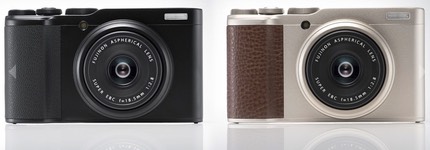Fujifilm appears to be taking on the old Nikon role: re-using sensors and slightly iterating camera designs to proliferate models without taking on much in the way of additional costs. This was a strategy Nikon used early in the century to introduce a complete DSLR lineup. Fujifilm is now doing the same for compacts and mirrorless.

Today Fujifilm introduced the XF10, a very small, light, near pocketable compact camera available in all black or "champagne gold" (looks brown and tan to me). It inherits the basic body design from the X70, and gets its Bayer sensor from the X-A5 and X-T100. Indeed, the couple of functions that the XF10 adds to Fujifilm's growing feature list (e.g. square images for Instagram) will be added to the X-A5 and X-T100 firmware next month, making for a trio of entry camera choices with nearly the same feature set and image quality.
Here's the important bit: the price of this big-sensor compact is US$500. That's for a 24mp APS-C camera with an 18.5mm (28mm equivalent) f/2.8 lens. I've been very impressed with that sensor in the X-A5 and X-T100, so now we have yet another variation at an entry price point that represents yet another unique model.
Downsides? 15 fps for 4K video, not 24 or 30. No EVF (built-in or optional). A physical shutter with a 1/4000 upper limit. USB 2.0 connectivity. 330 shots CIPA with the NP-95 battery. Largish raw file sizes.
Upsides? A bit wider but otherwise similar in size to the Sony RX100. That excellent 24mp Sony APS-C sensor. 9.8 ounce (279g) weight. Phase detect autofocus at up to 6 fps. US$500 price.
That said, the APS-C sensor compact has proven to be a tricky space. The two long-term players here are the Fujifilm X100 and Ricoh GR models, which are higher end products with more professional oriented features. Fujifilm seems to be targeting the XF10 as a more casual-user camera, complete with more reliance on flicking the LCD screen to do things. The build quality and control aspects of the XF10—along with the sensor/part reuse—are what lets it come in at a lower price. The operant question is how much of a market is there for a low-end camera with a high-end sensor?
Still, Fujifilm is slowly rolling out a very wide and interesting lineup, much like Nikon did in the early DSLR era.
Virtually all DSLR users I know have a "pocket camera" in their arsenal. I put "pocket" in quotes because there seems to be a fairly wide range of what that means, everything from the truly pocketable RX100 up to something like an E-M10m3 with a small prime. Well, now they have another choice. I've already reviewed the sensor in my X-A5 review, and will again in my upcoming X-T100 review. I have no issues at all with the image quality, though the focus performance is not state-of-the-art phase detect. So it's really going to be handling that makes or breaks the XF10 in the market, I think.





